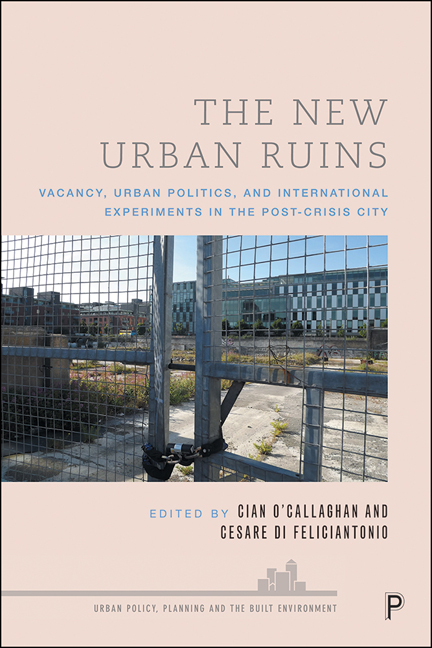Book contents
- Frontmatter
- Contents
- List of figures and tables
- Notes on contributors
- Acknowledgements
- Introduction
- PART I Rethinking ruination in the post-crisis context
- PART II The political economy of urban vacant space
- PART III Reappropriating urban vacant spaces
- Conclusion: Centring vacancy – towards a research agenda
- Index
1 - Rem(a)inders of loss: a Lacanian approach to new urban ruins
Published online by Cambridge University Press: 13 May 2022
- Frontmatter
- Contents
- List of figures and tables
- Notes on contributors
- Acknowledgements
- Introduction
- PART I Rethinking ruination in the post-crisis context
- PART II The political economy of urban vacant space
- PART III Reappropriating urban vacant spaces
- Conclusion: Centring vacancy – towards a research agenda
- Index
Summary
What is new about new urban ruins?
In recent years, human geography and other related fields have developed an increasing interest in ruins of the recent past. Expressions such as ‘ruins of modernity’ (Dawdy, 2010; Hell and Schönle, 2010), ‘industrial ruins’ (Edensor, 2005; Mah, 2012) or ‘new ruins’ (Kitchin et al, 2014; Martin, 2014) bear witness to rising attention to the relevance of studying material leftovers of our time. Throughout these debates, several attempts have been made to define what is ‘new’ about ruins of today. Kitchin et al (2014) consider the ruins that appeared after the global financial crisis in 2008 as a new form of ruination because, here, ruins were not a result of disuse, but a product of speculation about a promised future. The ‘ghost estates’ in Ireland, for instance, have never been used and are therefore considered testimonies of novel financialised forms of urbanisation. Another differentiation between ‘old’ and ‘new’ ruins can be found in Dylan Trigg's (2009: 142–50) The Aesthetics of Decay. Comparing ‘classical’ and post-industrial ruins, Trigg pursues the argument that the classical ruin, in contrast to the ruin of the present, is no longer considered as in an active process of decay, which allows us to perceive it as an absolute object in order, which might even be viewed as a beautiful object. In the ruin of the present, however, the process of decay is still ongoing, offering an understanding of ruins as structures in which decay is still hovering. In the new ruin, disorder and ongoing destruction predominate aesthetic perception.
Relying on the basic assumption that ruins of today – more so than the classical ruins of Rome and elsewhere – operate as objects of loss, this chapter contributes to the debate on new urban ruins. What is ‘new’ about new urban ruins is, in my view, not only their active process of decay, but also, and more importantly, their active transformation into ruins in the first place. The novelist Rose Macaulay was the first who addressed new ruins in this way.
- Type
- Chapter
- Information
- The New Urban RuinsVacancy, Urban Politics, and International Experiments in the Post-Crisis City, pp. 21 - 34Publisher: Bristol University PressPrint publication year: 2021



